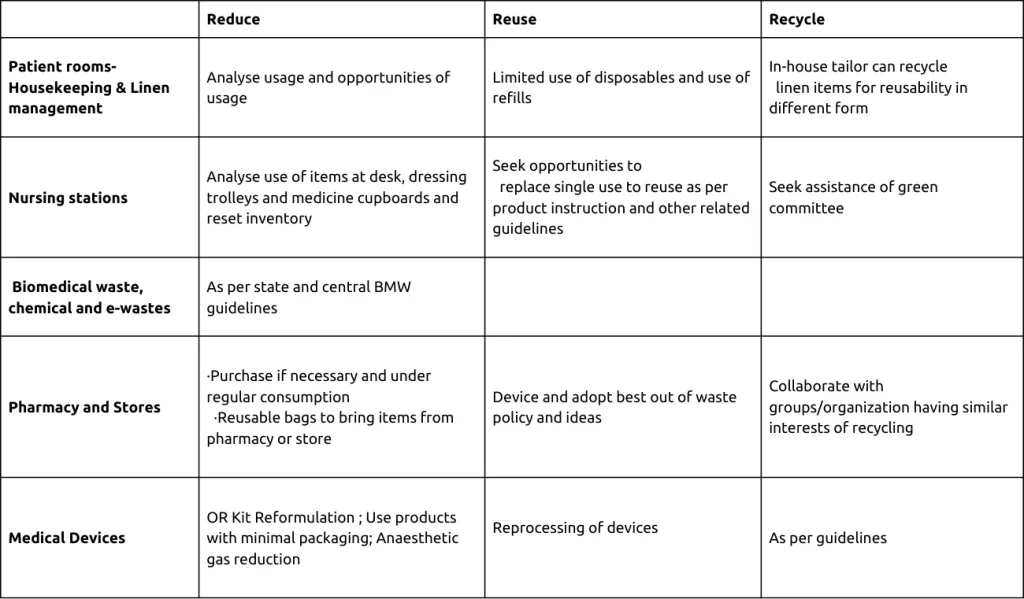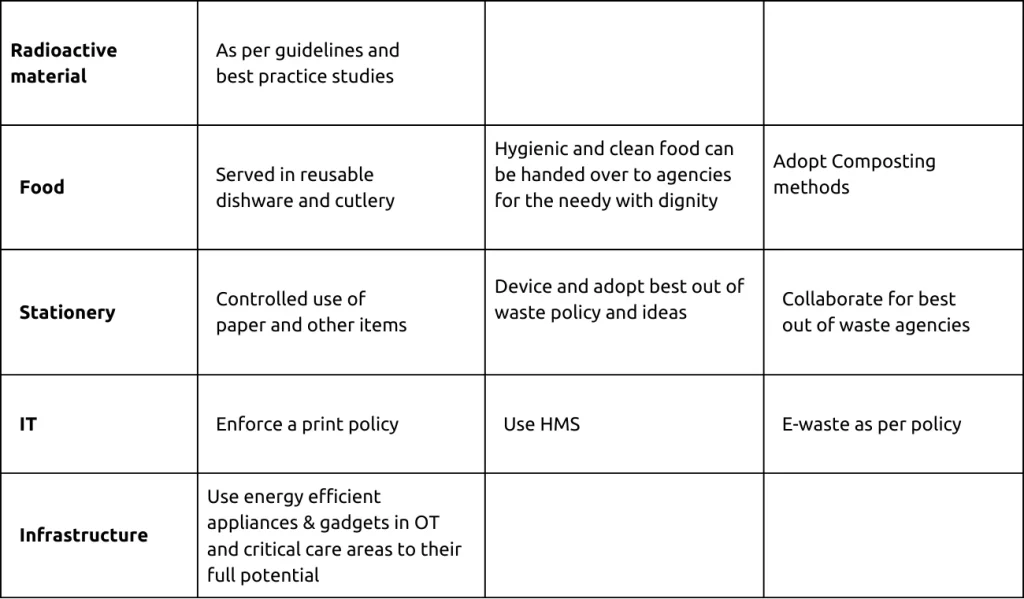Reduce, Reuse & Recycle: Possible ways in a healthcare setup
Read the Magazine in PDF
The most debatable topic today remains to be Global warming and the protection of our natural resources by reducing the amount of waste produced and its catastrophic impact on the planet.
WHO’s response to these challenges centres around 3 main objectives;
- Promote actions that both reduce carbon emissions and improve health
- Build better, more climate-resilient and environmentally sustainable health systems
- Protect health from the wide range of impacts of climate change.
Keeping in mind the objectives laid down by WHO, every healthcare care, whether a 2000-bed teaching hospital or a 10-bed nursing home can contribute to the benefits of Reducing, Reusing and recycling to help sustain the environment for future generations.
According to WHO this can be achieved by:
- Leadership and Raising Awareness
- Evidence and Monitoring
- Capacity Building and Country Support
Becoming a holistically cost-effective healthcare organization and partnering with the national and global mission of creating an eco-friendly atmosphere can be achievable by a focused action plan and setting realistic targets to achieve the set goals in a healthcare organization.
Each healthcare setup first needs to assess the different areas in the hospital, about the type and quantity of items that are required and used, then reconfirm and reposition its requirements, followed by analysing its reusability and lastly recycling methods. A few of the major and vital areas of consumption are Nursing stations, OT, CSSD, LAB, Housekeeping and linen management, Kitchen and so on.
Employee engagement
Employee participation is one of the major contributions to any achievement. The timeline and duration of achievement are directly proportional to the number of employees involved in the mission. Thus rate of consumption, waste generation and recycling effectiveness depends on the motivation, involvement, and encouragement of the employees. Creating opportunities to gain their support will go a long way to reducing your organization’s carbon footprint while building a more positive eco-friendly culture.
Some of the ways this can be done are:
- Leadership support and involvement: share the objectives and goal, communicate the action plan and share ownership
- Start a green team: Establish a committee that can formulate a mission statement and reach out to all areas of the organization to motivate action.
- Encourage a lot of brainstorming sessions – these sessions may be converted to achievable target-oriented goals.
- The committee may lead by example by adopting to limited consumption practices and Zero waste.
- Encourage innovative/unique ideas and executive them example, once a week “no car day/ car pool day” etc
- Acknowledge and applaud. Recognise employee’s actions and contributions.
- Develop policies and guidelines based on the positive outcome of the action plan. For example, enforce a ‘Print policy’.
- Set targets and monitor and report on success.
The below sample table is designed as an example to assist in self-assessing own status in the process of contributing to Reduce, Reuse, Recycle in different areas of their setup:
- Encourage a lot of brainstorming sessions – these sessions may be converted to achievable target-oriented goals.


Here are some ways to reduce in a hospital;
- Strict adherence to BMW management state and centre guidelines and compliance training.
- Post signage for a better understanding of doing the right thing and preventing wastage.
- Before buying a product, check if it can be used again. In addition, review the instructions of the manufacturers along with the state regulations to ensure you’re allowed to reuse the product.Replace single-use products with reusable products (if recommended keeping intact the safety of patients, employees and the hospital)
- Perform waste audits -periodically review to see if your plan is coming to actionable goals and if your medical waste is being disposed of properly. Let your staff know about the findings and retain them if necessary.
Recommendations
- Composting: Wet waste or food waste is one of the major contributors to the total waste produced in a healthcare organization. Out of the 3 Rs recycling, if done by the best method suitable for the set up may be adopted to reduce the amount of greenhouse gases that are sent into the atmosphere and the best way to do this is by composting. Those organisations that have the scope of backyard or vermicomposting may think about doing so as sending to landfill, which leads to decomposing in the absence of oxygen contributing to methane production.
- Energy management: The energy management topic may be a key point of concern to be discussed with management to ensure ongoing attention and confirmed timely resolution. This can be achieved by Monitoring and analysing the energy consumption regularly and benchmarking the amount of energy used in your organization. Advocating energy-saving opportunities by bringing process change. Biomedical equipment both critical and non-critical, downtime must be analysed for the payback period and initiative must be taken for the best opportunities to lower consumption and cost.
“Reuse and upcycling of common household goods have been an integral part of Indian culture. Taking a cue from this shared habit, the Ministry of Housing and Urban Affairs (MoHUA) campaign – ‘Meri LiFE, Mera Swachh Shehar’ is launched to champion the RRRs of waste management- Reduce, Reuse, and Recycle.” -Ministry of Housing and Urban Affairs, Govt. of India
Healthcare organization and setups may further take a cue from the government campaign and collaborate for the mission to protect and preserve environment by bringing about a behavioural and process change in our day to day healthcare activity.
References
https://www.turnbackthetide.ca/taking-action/businesses/energy-management.shtml medical -systems.com MyGov Innovate India Perspectives.
Author
-

Director Operations, Apple Hospital and Research Centre, Indore



